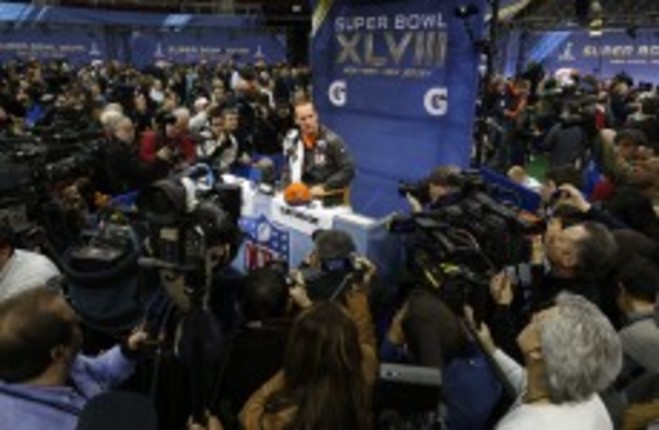Updated at 10am
1. “Barely two decades ago, it was permissible for a goalkeeper to handle a backpass. “To handle”, in football-speak, meant to pick the ball up, clutch it longingly to the chest while scouring the expanses of the pitch in front, bounce it a couple of times and, finally, to boot it emphatically as far into the opposing half as humanly possible. And none of these fancy, out-to-the-side, flat-trajectory, counter-attack-launching kicks that are so fashionable now.”
The Guardian‘s tribute to the long-forgotten backpass reminds us of the times when it all went wrong.
2. “I threw a choking sign at 49ers quarterback Colin Kaepernick. Why? Because he decided he was going to try the guy he was avoiding all game, because, I don’t know, he’s probably not paying attention for the game-winning play. C’mon, you’re better than that.
“Erin Andrews interviewed me after the game and I yelled what was obvious: If you put a subpar player across from a great one, most of the time you’re going to get one result. As far as Crabtree being a top-20 NFL receiver, you’d have a hard time making that argument to me. There are a lot of receivers playing good ball out there, and Josh Gordon needed 14 games to produce almost double what Crabtree can do in a full season. And Gordon had Brandon Weeden, Brian Hoyer and Jason Campbell playing quarterback.”
Seattle Seahawk cornerback Richard Sherman writes about that TV interview for Sports Illustrated.
3. “Let’s start at the beginning. Every March, anywhere from 100 to 300 young women and men try out for one of the 30 or 40 available spots on the Ravens’ stunt and dance teams. The girls range from dance specialists, experts at the physical aspects of cheer, to pretty faces more interested in the quasi-modeling parts of the job.
“Those who combine real talent with the right look—”big boobs, flat stomach, pretty face,” per the former cheerleader—are ideal.”
Deadspin talk to a former NFL cheerleader about how women who take up the profession are treated by teams in the league.
4. When I first started playing Winning Eleven, scoring a goal was like trying to thread a needle while wearing mittens.
“For four days, I sat crosslegged on my bedroom floor, staring at the 12″ TV I’d bought with that year’s birthday money. With Brazil and Argentina, I took on the worst teams I could find—the globe’s soccer dispossessed, Austria and Saudi Arabia and Bruce Arena’s United States—and still lost by three, four, five goals. Once I got the hang of defense, the goals stopped completely, turning our games into scoreless midfield battles that left me with crushing headaches.”
W.M Akers writes about the life lessons sporting video games can teach us for The Classical.
5. In 1980, the NBA was something between a cult object and a burlesque act. Those of us who still followed the league did so with bags over our heads to hide our rueful grins. (Let it be said. I loved those late-1970s Seattle teams, and it was fun to watch Julius Erving come into the league and blow everybody’s mind.)
“The argument that the NBA was “too black” to market itself was seriously made by serious people in an age when an organized backlash against the achievements of the civil rights movement was asserting itself, as we saw in the courtroom and in coded language.
“The argument that the NBA was a “drug league” — which was really a variation on the former contention — was seriously made by serious people in an age when the “war” on drugs was gathering itself. More to the point, and partly because of these problems, the league was broke and floundering, its championship series famously being played on tape delay.”
Charles Pierce writes about David Stern’s legacy as Commissioner of the NBA over on Grantland.
6. “During that time, while Punk was having fantastic matches with the likes of Chris Jericho and Daniel Bryan, Cena was headlining pay-per-views against the likes of Kane, John Laurinatis and The Big Show. That’s a clear pattern of either no-confidence, disrespect, or both, depending on your perspective.
“It’s clear, CM Punk deserved better.
“Then he basically got shuffled to the mid-card, being forced to work with the likes of Curtis Axel, Ryback and Kane, which wasn’t exactly going to light anybody’s world on fire, all while the golden boy Randy Orton bored crowds to death from coast to coast.”
“He’s still under contract until July, but as of now, he’s not an active part of WWE.”
Bloody Elbow take a look at why one of the WWE’s most popular stars suddenly quit the company.

